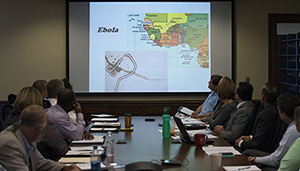Tuesday, August 19, 2014
Local Colleges and Healthcare Professionals Gather at LUCOM
Tue, 19 Aug 2014College of Osteopathic Medicine :: School of Health Sciences
On Friday, August 15, Liberty University College of Osteopathic Medicine (LUCOM) and the School of Health Sciences hosted over 30 professionals to discuss how to protect the public and mitigate any risk of an incident of the viral infection produced by Ebola Viral Disease (EVD) that might occur in Lynchburg and the surrounding region of Virginia. Representatives from Liberty University, Lynchburg College, Randolph College, Sweet Briar College, the Central Virginia Health District (CVHD), the Virginia Department of Health, and Centra Health Systems were in attendance, along with members of the Lynchburg Fire/EMS, Bedford County Department of Fire and Rescue, City of Lynchburg Department of Emergency Services, and Near Southwest Preparedness Alliance.
Opening the meeting with a short story about a Liberian colleague who lost a sister to Ebola was Richard Lane, M.D., MPH, FACPM, and Director of the Master of Public Health Program. “For the first time Ebola has been transferred by air travel on the African continent. While there have been no occurrences in the U.S., we are here today to join forces and prepare a collaborative plan to protect the health of not just our students, but the greater community. Our efforts are important to provide public confidence and security as well as protect their health.”
Each representative shared ideas for prevent-
ative screening, identification,  and potential
and potential
treatment of any patient exhibiting symptoms
of the Ebola virus should a suspect case be
presented. According to Kerry Gateley, M.D.,
Health Director for Central Virginia Health
District, there are approximately 50 inter-
national students coming to local colleges from
the affected countries (Guinea, Sierra Leone, Liberia, and Nigeria, West Africa).
“Those students who have a significant travel history, including students who have traveled on mission and medical outreach events in any
of the affected countries and who become ill with flu like symptoms in the 2-21 day incubation period of the virus should be screened and treated with an overabundance of caution. It is important that the public know the risk of EVD exposure in Central Virginia is extremely low and that healthcare and containment protocols are in place. The members of the committee discussed protocol to develop a screening questionnaire for returning citizens and students to further expand the safety for the public.
The committee stressed that the transportation, isolation and treatment protocols required to control contagious diseases like EVD in the U.S. are already in place and being followed and that supportive and treatment protocol for patients in the U.S. are highly effective in treating conditions such as hemorrhagic fevers like Ebola. Since the disease is not spread by respiratory mechanisms, while highly infectious if contacted directly, it is not highly contagious with proper handling of body secretions and fluids. Continued research utilizing recovered immunoglobulin and monoclonal antibodies, along with prophylactic vaccine testing continues at centers in the U.S. and across the globe.
The committee noted that while there are already being contacted by concerned citizens, at this time there are no concerns or issue of danger to the public or health care providers.
Concluding the meeting, Dr. Lane said, “Merging diseases occur, because we allow them too, often through neglect and failure to react. As health professionals, we need to remind the public and our students to maintain vigilance concerning their health and not assume a passive attitude. We already have a good system in place, yet there is always room for improvement and expansion of safety and quality. Our homework is never done.”
Dr. Richard Lane was recently interviewed on WDBJ-7 and WSET-ABC13 addressing public safety and awareness.
For more information about general health tips and local preparation, please contact Dr. Kerry Gateley at 434–947–6777 or Dr. Richard Lane at 434–592–5985.
About the Ebola Virus Disease (EVD)
EVD is a viral hemorrhagic fever. Early symptoms include fever, chills, headache, vomiting, diarrhea and myalgias. Skin rashes, redness of the eyes and other symptoms can occur. Hemorrhagic signs occur in less than half of infected patients of cases. The disease can become increasingly severe, progressing to shock, multi-organ failure, and death. Transmission of EVD is through direct contact with blood or body fluids (including but not limited to vomitus, urine, and stool) of an infected person or exposure to contaminated items, such as needles. Ebola virus is not readily transmitted through the air from person to person. Communicability begins with the onset of symptoms. Persons are not infectious during the incubation period. The disease is most transmissible during the later stages of illness, when viral loads are highest. Caution must be exercised when handling the clothes and linins of any patient with EVD.
For more information on the Ebola Virus Disease outbreak in West Africa, please follow the most recent updates provided by the Centers for Disease Control and Prevention (CDC).